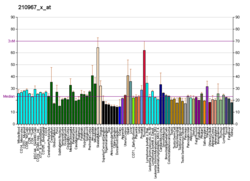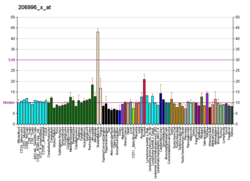CACNB1
CACNB1
Protein-coding gene in the species Homo sapiens
Voltage-dependent L-type calcium channel subunit beta-1 is a protein that in humans is encoded by the CACNB1 gene.[5][6][7]
The protein encoded by this gene belongs to the calcium channel beta subunit family. It plays an important role in the calcium channel by modulating G protein inhibition, increasing peak calcium current, controlling the alpha-1 subunit membrane targeting and shifting the voltage dependence of activation and inactivation. Alternative splicing occurs at this locus and three transcript variants encoding three distinct isoforms have been identified.[7]
Mutations in CACNB1 are known to cause the following conditions: Malignant Hyperthermia; Congenital Myopathy; Alzheimer's Disease; Autism Spectrum Disorder.[8]
- "Human PubMed Reference:". National Center for Biotechnology Information, U.S. National Library of Medicine.
- "Mouse PubMed Reference:". National Center for Biotechnology Information, U.S. National Library of Medicine.
- Gregg RG, Powers PA, Hogan K (January 1993). "Assignment of the human gene for the beta subunit of the voltage-dependent calcium channel (CACNLB1) to chromosome 17 using somatic cell hybrids and linkage mapping". Genomics. 15 (1): 185–187. doi:10.1006/geno.1993.1029. PMID 8381767.
- Iles DE, Segers B, Sengers RC, Monsieurs K, Heytens L, Halsall PJ, et al. (July 1993). "Genetic mapping of the beta 1- and gamma-subunits of the human skeletal muscle L-type voltage-dependent calcium channel on chromosome 17q and exclusion as candidate genes for malignant hyperthermia susceptibility". Human Molecular Genetics. 2 (7): 863–868. doi:10.1093/hmg/2.7.863. PMID 8395940.
- "CACNB1 Gene: Diseases". GeneCards.
- Williams ME, Feldman DH, McCue AF, Brenner R, Velicelebi G, Ellis SB, et al. (January 1992). "Structure and functional expression of alpha 1, alpha 2, and beta subunits of a novel human neuronal calcium channel subtype". Neuron. 8 (1): 71–84. doi:10.1016/0896-6273(92)90109-Q. PMID 1309651. S2CID 39341712.
- Perez-Reyes E, Castellano A, Kim HS, Bertrand P, Baggstrom E, Lacerda AE, et al. (January 1992). "Cloning and expression of a cardiac/brain beta subunit of the L-type calcium channel". The Journal of Biological Chemistry. 267 (3): 1792–1797. doi:10.1016/S0021-9258(18)46015-2. PMID 1370480.
- Powers PA, Liu S, Hogan K, Gregg RG (November 1992). "Skeletal muscle and brain isoforms of a beta-subunit of human voltage-dependent calcium channels are encoded by a single gene". The Journal of Biological Chemistry. 267 (32): 22967–22972. doi:10.1016/S0021-9258(18)50042-9. PMID 1385409.
- Pragnell M, Sakamoto J, Jay SD, Campbell KP (October 1991). "Cloning and tissue-specific expression of the brain calcium channel beta-subunit". FEBS Letters. 291 (2): 253–258. doi:10.1016/0014-5793(91)81296-K. PMID 1657644. S2CID 84984587.
- Collin T, Wang JJ, Nargeot J, Schwartz A (June 1993). "Molecular cloning of three isoforms of the L-type voltage-dependent calcium channel beta subunit from normal human heart". Circulation Research. 72 (6): 1337–1344. doi:10.1161/01.res.72.6.1337. PMID 7916667.
- Fukuda K, Kaneko S, Yada N, Kikuwaka M, Akaike A, Satoh M (October 1996). "Cyclic AMP-dependent modulation of N- and Q-type Ca2+ channels expressed in Xenopus oocytes". Neuroscience Letters. 217 (1): 13–16. doi:10.1016/0304-3940(96)13055-X. PMID 8905728. S2CID 40498858.
- Gregg RG, Messing A, Strube C, Beurg M, Moss R, Behan M, et al. (November 1996). "Absence of the beta subunit (cchb1) of the skeletal muscle dihydropyridine receptor alters expression of the alpha 1 subunit and eliminates excitation-contraction coupling". Proceedings of the National Academy of Sciences of the United States of America. 93 (24): 13961–13966. doi:10.1073/pnas.93.24.13961. PMC 19477. PMID 8943043.
- Brice NL, Dolphin AC (March 1999). "Differential plasma membrane targeting of voltage-dependent calcium channel subunits expressed in a polarized epithelial cell line". The Journal of Physiology. 515 (Pt 3): 685–694. doi:10.1111/j.1469-7793.1999.685ab.x. PMC 2269176. PMID 10066897.
- Lie AA, Blümcke I, Volsen SG, Wiestler OD, Elger CE, Beck H (1999). "Distribution of voltage-dependent calcium channel beta subunits in the hippocampus of patients with temporal lobe epilepsy". Neuroscience. 93 (2): 449–456. doi:10.1016/S0306-4522(99)00162-1. PMID 10465427. S2CID 12890647.
- Hogan K, Greg RG, Powers PA (December 1999). "Structure and alternative splicing of the gene encoding the human beta1 subunit of voltage dependent calcium channels". Neuroscience Letters. 277 (2): 111–114. doi:10.1016/S0304-3940(99)00851-4. PMID 10624822. S2CID 32210526.
- Finlin BS, Crump SM, Satin J, Andres DA (November 2003). "Regulation of voltage-gated calcium channel activity by the Rem and Rad GTPases". Proceedings of the National Academy of Sciences of the United States of America. 100 (24): 14469–14474. doi:10.1073/pnas.2437756100. PMC 283615. PMID 14623965.
- Navarro-Lérida I, Martínez Moreno M, Roncal F, Gavilanes F, Albar JP, Rodríguez-Crespo I (February 2004). "Proteomic identification of brain proteins that interact with dynein light chain LC8". Proteomics. 4 (2): 339–346. doi:10.1002/pmic.200300528. PMID 14760703. S2CID 8868600.
- Foell JD, Balijepalli RC, Delisle BP, Yunker AM, Robia SL, Walker JW, et al. (April 2004). "Molecular heterogeneity of calcium channel beta-subunits in canine and human heart: evidence for differential subcellular localization". Physiological Genomics. 17 (2): 183–200. doi:10.1152/physiolgenomics.00207.2003. PMID 14762176. S2CID 38889757.
- Lim J, Hao T, Shaw C, Patel AJ, Szabó G, Rual JF, et al. (May 2006). "A protein-protein interaction network for human inherited ataxias and disorders of Purkinje cell degeneration". Cell. 125 (4): 801–814. doi:10.1016/j.cell.2006.03.032. PMID 16713569. S2CID 13709685.
- Olsen JV, Blagoev B, Gnad F, Macek B, Kumar C, Mortensen P, et al. (November 2006). "Global, in vivo, and site-specific phosphorylation dynamics in signaling networks". Cell. 127 (3): 635–648. doi:10.1016/j.cell.2006.09.026. PMID 17081983. S2CID 7827573.
- CACNB1+protein,+human at the U.S. National Library of Medicine Medical Subject Headings (MeSH)
- Human CACNB1 genome location and CACNB1 gene details page in the UCSC Genome Browser.
This article incorporates text from the United States National Library of Medicine, which is in the public domain.
This membrane protein–related article is a stub. You can help Wikipedia by expanding it. |







